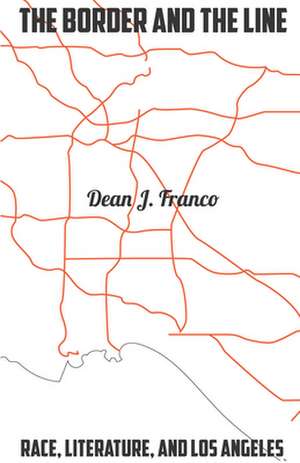The Border and the Line – Race, Literature, and Los Angeles: Stanford Studies in Comparative Race and Ethnicity
Autor Dean J. Francoen Limba Engleză Paperback – 14 ian 2019
The Border and the Line takes up the central conceit of "the neighbor" to consider how the geography of racial identification and interracial encounters are represented and even made possible by literary language. Dean J. Franco probes how race is formed and transformed in literature and in everyday life, in the works of Helena Mar a Viramontes, Paul Beatty, James Baldwin, and the writers of the Watts Writers Workshop. Exploring metaphor and metonymy, as well as economic and political circumstance, Franco identifies the potential for reconciliation in the figure of the neighbor, an identity that is grounded by geographical boundaries and which invites their crossing.
| Toate formatele și edițiile | Preț | Express |
|---|---|---|
| Paperback (1) | 168.36 lei 3-5 săpt. | |
| MK – Stanford University Press – 14 ian 2019 | 168.36 lei 3-5 săpt. | |
| Hardback (1) | 642.86 lei 6-8 săpt. | |
| MK – Stanford University Press – 14 ian 2019 | 642.86 lei 6-8 săpt. |
Preț: 168.36 lei
Nou
32.21€ • 33.64$ • 26.60£
Carte disponibilă
Livrare economică 25 martie-08 aprilie
Specificații
ISBN-10: 1503607771
Pagini: 224
Dimensiuni: 141 x 214 x 17 mm
Greutate: 0.3 kg
Editura: MK – Stanford University Press
Seria Stanford Studies in Comparative Race and Ethnicity
Cuprins
The chapter posits a theory of how race materializes through the production of space. With reference to Ernesto Laclau's rhetorical theory, the introduction examines how metaphor and metonymy correspond to the social and political significance of racial identification. Thus the Introduction aligns the contingent formation of racial and religious identities with metonymy, or the material experience of being-in-place, and aligns static racial names with metaphor. The Introduction theorizes the terms border and line as interrelated figures of spatial constraint and access. Each term has a normative and a transgressive meaning, and the Introduction explores how and when the normative meaning of one term is in play, the transgressive meaning of the other term likewise emerges.
This chapter takes on a fundamental question for literature scholars: How can readers bear responsibility for the literature they read and love? The chapter argues that the reader becomes the neighbor to the literature, and follows with an exploration of the philosophical and material implications of that neighboring. The chapter examines Helena María Viramontes's novel Their Dogs Came with Them, set in Boyle Heights at the peak of its gang wars in the 1970s, and explores the real neighborhood, including the activist project Union de Vecinos, a socialist organizing collective inspired by liberation theology to reclaim the neighborhood, from both the gangs and reactionary policing, in the name of social justice. In both examples, the chapter posits the concept of the miracle as something worldly and material, capable of transformation.
The first half of this chapter explores the Watts Writers Workshop, founded in the heart of Watts by Budd Schulberg after the Watts Riots in 1965. Schulberg created Frederick Douglass House, a charitable foundation and a physical building for black creative arts, and the chapter argues that Schulberg's personal and financial investment in Watts relocated his political standing as the "neighbor" to the Watts writers with whom he worked. The chapter examines a conversation between Schulberg and his friend James Baldwin, about the meaning of "race." Both writers hit upon "love" as the only way to cut through the Gordian knot of racism binding the nation. The chapter closes with a study of Paul Beatty's Los Angeles novel, The Sellout (2015), in which love is ironized and black Angelenos assert an atavistic claim on property, with segregation, plantations, and the return of slavery.
This chapter argues for the emergence of privately held ethics in the formation of neighborhood publics. The chapter primarily focuses on Jewish neighborhoods, including the L.A. Eruv, the largest in the West. An eruv is an area with boundaries designated by a rabbinical authority to constitute domestic rather than public space for Jews living within. Eruv is Hebrew for "mixture," and it involves mixing public and private spaces into one large "courtyard" or domestic enclosure. The chapter argues that the eruv is a "counter-public" for the Orthodox space it circumscribes, but that the public alignment of "Jewish" with "Orthodox" eclipses other kinds of Jewish publics in Los Angeles. The chapter compares the idea of the neighborhood in the eruv with Jewish concepts of the neighborhood in a recent short documentary, My Neighbourhood, about secular Israeli Jews who partner with Muslim Palestinians to protest Orthodox Jewish appropriation of Palestinians' homes.
This chapter argues for the value of comparative analysis in studies of race and ethnicity, and makes the case for the inclusion of Jewish studies in the ethnic studies matrix. The Conclusion reviews the parallel but distinct histories of ethnic studies and Jewish studies, and explains the basis of their mutual exclusion. The Conclusion posits the book's critical motif of "the neighborhood" as the apt figure for reconciling different academic accounts of race and ethnicity, and for seeking understanding through unexpected comparisons across racial groups.







